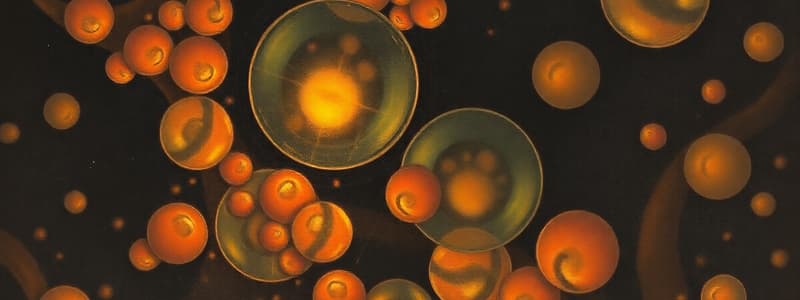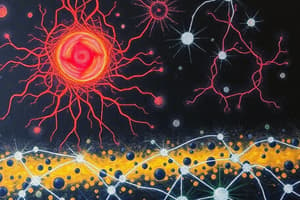Podcast
Questions and Answers
What is the primary function of the plasma membrane?
What is the primary function of the plasma membrane?
- Regulation of cellular metabolism
- Facilitation of cell division
- Protection of the cell from its environment (correct)
- Synthesis of membrane proteins
Which component is primarily responsible for maintaining membrane fluidity at various temperatures?
Which component is primarily responsible for maintaining membrane fluidity at various temperatures?
- Proteins
- Phospholipids
- Cholesterol (correct)
- Carbohydrates
Which type of lipid is most abundant in biological membranes?
Which type of lipid is most abundant in biological membranes?
- Sterols
- Glycolipids
- Fatty acids
- Phospholipids (correct)
What structural feature of phospholipids allows them to form bilayers in aqueous environments?
What structural feature of phospholipids allows them to form bilayers in aqueous environments?
Which type of membrane protein is primarily involved in cell signaling?
Which type of membrane protein is primarily involved in cell signaling?
Which of the following lipids comprises only a small fraction of total membrane lipids?
Which of the following lipids comprises only a small fraction of total membrane lipids?
Which other component, alongside proteins, is predominantly found in plasma membranes?
Which other component, alongside proteins, is predominantly found in plasma membranes?
Who first proposed the fluid mosaic model of plasma membrane structure?
Who first proposed the fluid mosaic model of plasma membrane structure?
What is the primary role of carbohydrates on the surface of eukaryotic cells?
What is the primary role of carbohydrates on the surface of eukaryotic cells?
Which type of protein spans the cell membrane and interacts with both internal and external molecules?
Which type of protein spans the cell membrane and interacts with both internal and external molecules?
What characteristic distinguishes peripheral proteins from integral proteins?
What characteristic distinguishes peripheral proteins from integral proteins?
Which of the following types of proteins are typically covalently bonded to lipid molecules?
Which of the following types of proteins are typically covalently bonded to lipid molecules?
What type of channel is usually facilitated by integral proteins to allow specific ions to move across the membrane?
What type of channel is usually facilitated by integral proteins to allow specific ions to move across the membrane?
How do G proteins typically interact with other proteins within the membrane environment?
How do G proteins typically interact with other proteins within the membrane environment?
What is the main function of the plasma membrane in cells?
What is the main function of the plasma membrane in cells?
What do the hydrophobic regions of integral membrane proteins primarily consist of?
What do the hydrophobic regions of integral membrane proteins primarily consist of?
Flashcards
Plasma Membrane Structure
Plasma Membrane Structure
A biological membrane composed of a lipid bilayer that separates the cell's interior from its surroundings, protecting from the environment. It includes phospholipids, cholesterol, and proteins.
Fluid Mosaic Model
Fluid Mosaic Model
The model explaining the plasma membrane structure, proposed by Singer and Nicolson in 1972, depicting a fluid-like, dynamic arrangement of molecules.
Lipid Bilayer
Lipid Bilayer
The basic structure of the plasma membrane, composed of two layers of lipids arranged tail-to-tail.
Phospholipids
Phospholipids
Signup and view all the flashcards
Hydrophilic Head
Hydrophilic Head
Signup and view all the flashcards
Hydrophobic Tails
Hydrophobic Tails
Signup and view all the flashcards
Membrane Proteins
Membrane Proteins
Signup and view all the flashcards
Membrane Functions
Membrane Functions
Signup and view all the flashcards
Membrane Lipids (classes)
Membrane Lipids (classes)
Signup and view all the flashcards
Membrane Carbohydrates
Membrane Carbohydrates
Signup and view all the flashcards
Carbohydrates in Cell Recognition
Carbohydrates in Cell Recognition
Signup and view all the flashcards
Plasma Membrane
Plasma Membrane
Signup and view all the flashcards
Integral Proteins
Integral Proteins
Signup and view all the flashcards
Membrane Transporters
Membrane Transporters
Signup and view all the flashcards
Peripheral Proteins
Peripheral Proteins
Signup and view all the flashcards
Lipid-anchored proteins
Lipid-anchored proteins
Signup and view all the flashcards
Hydrophobic Domain
Hydrophobic Domain
Signup and view all the flashcards
Hydrophilic Domain
Hydrophilic Domain
Signup and view all the flashcards
Study Notes
Plasma Membrane and Membrane Proteins
- Plasma membrane separates the interior of the cell from its environment
- It acts as a biological membrane, protecting the cell
- The membrane is a lipid bilayer, with phospholipids and cholesterol as key components, maintaining fluidity at varying temperatures
- The fluid mosaic model describes the membrane's structure, proposed by Singer and Nicolson in 1972
- The model shows embedded proteins like integral, peripheral, and lipid-anchored proteins
- Integral proteins span the membrane, having hydrophilic and hydrophobic domains interacting with internal and external molecules
Proteins of Plasma Membrane
- Integral proteins span the membrane and have hydrophobic membrane-spanning regions, which interact with internal and external molecules; examples include ion channels, proton pumps, and G protein-coupled receptors
- Lipid-anchored proteins are linked to the membrane via covalent bonds with lipids; they don't directly interact with the membrane, instead embedding into the lipid bilayer
- Peripheral proteins bind to integral membrane proteins or lipid bilayer regions; they have temporary interactions with the membrane
Carbohydrates in Plasma Membrane
- Plasma membranes contain carbohydrates (predominantly glycoproteins, but also glycolipids)
- Carbohydrates play roles in cell-cell recognition
- Recognition happens on the cell surface, where carbohydrates recognize host cells
- Viruses can use these receptors to cause infection
Membrane Fluidity and Dynamics
- Material can be incorporated into or removed from the membrane via exocytosis and endocytosis, respectively
- Exocytosis involves fusion of intracellular vesicles with the membrane
- Endocytosis involves the membrane forming blebs around extracellular material that then pinch off into vesicles
Functions of Plasma Membrane
- Controls substance movement in and out of cells; selectively permeable to ions and certain molecules
- Provides a physical barrier between the external environment and inner cell organelles, including communication and signaling between cells
- Anchors the cytoskeleton, contributing to the cell's shape and maintaining cell potential
Studying That Suits You
Use AI to generate personalized quizzes and flashcards to suit your learning preferences.



